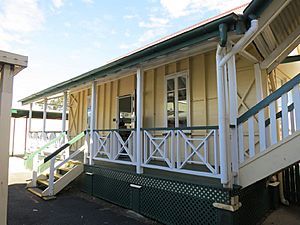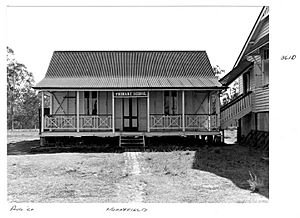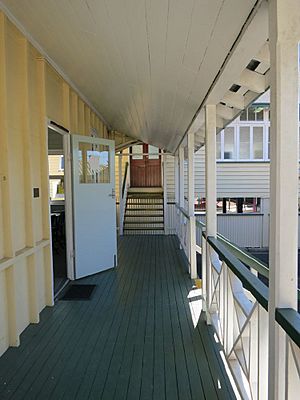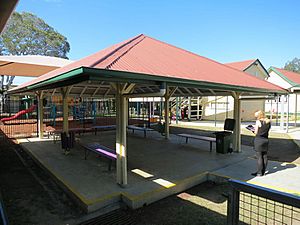Morayfield State School facts for kids
Quick facts for kids Morayfield State School |
|
|---|---|

Morayfield State School, original building, 2014
|
|
| Location | 196–230 Morayfield Road, Morayfield, City of Moreton Bay, Queensland, Australia |
| Built | 1873, 1903 |
| Built for | Department of Public Instruction |
| Architect | Richard George Suter |
| Official name: Morayfield State School; Caboolture National School; Caboolture South State School | |
| Type | state heritage |
| Designated | 10 October 2014 |
| Reference no. | 602839 |
| Type | Education, research, scientific facility: School-state |
| Theme | Educating Queenslanders: Providing primary schooling |
| Builders | Robert Monteith, Thomas Heron |
| Lua error in Module:Location_map at line 420: attempt to index field 'wikibase' (a nil value). | |
Morayfield State School is a special old school in Morayfield, Queensland, Australia. It is listed on the Queensland Heritage Register because of its important history. The school was designed by an architect named Richard George Suter and first built in 1873. It was originally known as Caboolture National School.
School History
Morayfield State School first opened its doors on August 4, 1873. It was called Caboolture National School back then. The school started in a small timber building designed by architect Richard George Suter. It was built on a large piece of land south of the Caboolture River. The school was meant for the families living in the growing farming area.
As more people moved to the area, the school grew. It added more buildings and features over time. This included a play shed in 1903 and many shade trees. The school has been open continuously since it started. It has always been a central place for the local community. People have gathered there for important social and cultural events.
Early Days of the Area
The area around Caboolture was first opened for free settlers in 1842. Before that, it was a penal colony. People first used the river to transport timber, especially red cedar. In the 1860s, the area became known for farming. It was one of the first places in Queensland to grow sugarcane on a large scale.
Two big sugar plantations were in the area. One was "Moray Field," owned by George Raff. The other was "Oaklands," owned by Captain Claudius Buchanan Whish. Both plantations used workers from the South Sea Islands.
Why the School Was Built
Caboolture was a stop on the road to the Gympie goldfield in the late 1860s. The area grew enough to need a government school. It was built "for the convenience of the farmers' families up the river, and the children of the employees at Mr Raff's plantation."
In April 1872, the Queensland Government set aside 41 acres of land for the school. This land was next to the Gympie Road. Even though it was 2.5 km south of Caboolture, it had a good water source. There were lagoons on Sheep Station Creek nearby.
Education in Queensland
Setting up schools was very important for early communities. It helped them grow and succeed. Local people often gave land and helped build the schools. The school community also helped with upkeep and improvements.
Schools became a main place for social events. They showed how much a community was growing. Many people felt proud of their local school. Former students, parents, and teachers often kept strong connections to the school.
Schools hosted many events like fetes, markets, and holiday celebrations. They also held school break-up days, fundraisers, and sporting events. This made schools a vital part of community life.
From the 1860s to the 1960s, most Queensland school buildings were made of timber. This was because timber was easy to find. Many builders knew how to work with it. This made building schools easy and affordable. It also helped the government build schools in faraway places.
Schools across Queensland were built in similar ways. They usually had teaching buildings, a school yard, a sports oval, and a head teacher's house. They also had play sheds, gardens, and trees.
Building the First School
Robert Monteith won the contract to build the Caboolture National School. He built a teaching building and a head teacher's house for £265. Both buildings were finished in 1873. The school opened on August 4, 1873. By December 1873, 34 children were attending the school.
The teaching building (now called Block C) was designed by Richard Suter. He was an architect who designed many school buildings for the government. Suter often used a special building style called "outside studding." This meant the timber frame was visible on the outside of the building. This style became very common in Queensland.
Improving School Designs
Early school designs were sometimes too hot inside. In 1873, an "improved plan" was created. This new design had a single large room with verandahs on the front and back. These verandahs offered protection from the weather. They also gave sheltered space for play and teaching. This design became a common feature of Queensland schools for many years.
Suter's designs were used widely across Queensland. This helped spread the "outside studding" building style. About 65 timber school buildings were built using Suter's standard plans. Today, only three of these are still mostly in their original form. Morayfield State School is one of them.
The classroom building at Caboolture National School was a typical Suter design. It was a low-set timber building with outside studding. It had verandahs on the east and west sides. The main room was 30 by 16 feet. The roof was covered with timber shingles. The inside walls were lined with pine timber boards.
Later school architects focused on making classrooms better. They wanted to improve air flow, lighting, and ventilation. They made windows larger to let in more light. This made classrooms brighter and airier.
School Name Changes
The Caboolture/Morayfield area continued to grow in the 1870s and 1880s. In 1888, the North Coast railway line was built. Its end stop was in North Caboolture. This led to a new school, North Caboolture State School, opening in 1889.
Because of the new school, Caboolture State School was renamed Caboolture South State School in 1889. Later, in 1907, it was renamed Morayfield State School.
Adding a Playshed
In 1903, the school committee asked to build a playshed. It was finished later that year. The local community helped pay for one-third of the cost.
Playsheds were common additions to Queensland schools. They were open-sided timber structures. They provided a covered space for play. Sometimes, they were used for teaching too. They usually had a hipped roof and fixed timber seating. The playshed at Morayfield State School was built to a standard design. It was 24 by 16 feet and had six posts supporting its roof.
School Grounds and Trees
School grounds were also developed for outdoor play. The government believed that play was important for primary school children. Trees and gardens were planted to make schools look nicer.
Arbor Day celebrations started in Queensland in 1890. Caboolture South State School held Arbor Day events by 1891. People believed gardening taught children hard work and improved discipline. It also made schools more beautiful.
A report from 1958 mentioned a very old and beautiful fig tree at Morayfield State School. This tree provided shade all year round. Photographs from 1956 and 1973 show the fig tree as a large, mature tree. It stood in a playground that had few other trees. The soil at Morayfield is shallow, so trees do not grow quickly. This means the fig tree is likely very old.
Modern Changes and Growth
Between the 1960s and 1980s, Queensland education changed a lot. The buildings at Morayfield State School were updated. New ideas about teaching led to new building designs. Timber was no longer the main building material.
Starting in the 1970s, Morayfield's population grew very quickly. The number of people in the Caboolture Shire increased by 65.5% between 1971 and 1976.
Morayfield State School also grew rapidly. Between 1970 and 1990, many new buildings were added. These included classrooms, toilets, a library, and an administration block. The original Suter building was changed in 1977 to be used as a staff room. By 2014, it was used as a Student Behaviour Room.
Today, Morayfield State School still operates on the same site. It still has the original Suter building, the playshed, and the large shade tree. The school has been important to the community since 1873. It has taught many generations of students. It remains a key gathering place for social events in Morayfield.
School Features
Morayfield State School is located south of Morayfield's main town area. The school covers a large, 16.5-hectare piece of land. It is at the corner of Morayfield Road and Caboolture River Road. The school has many buildings, including the original Suter-designed teaching building from 1873. It also has a timber playshed from around 1903. A large, old fig tree stands near the playshed, giving shade to the school grounds.
The Suter Building
The Suter building is in the middle of the school. It is a small, low-set timber building. It has a gable roof covered with corrugated metal. The building has verandahs on the front (east) and back (west). Small timber stairs lead up to these verandahs.
The verandahs have timber posts and floors. The walls of the verandahs are single-skin, meaning you can see the timber frame on the outside. There are doors leading into the main room from both verandahs. The eastern verandah has a decorative timber railing. The western verandah has bag racks instead of a railing.
The western verandah has small storage rooms at its ends. A plaque on the eastern verandah wall says, "Morayfield State School, Opened 4 August 1873." The ends of the building have modern windows under horizontal covers.
Inside, the classroom walls and ceiling are lined with horizontal timber boards. The timber roof frame is visible inside. The carpet, linoleum floor, and some other items are modern additions.
The Playshed
The playshed is north of the Suter building. It is a 24 by 16-foot structure. It has a hipped roof made of corrugated metal. Six timber posts support the roof. All the roof timbers are visible inside. The modern seats and concrete floor are not part of its original design.
The Fig Tree
A large, mature fig tree provides shade to the area east of the playshed. Its lower branches have been trimmed. You can still see the stump where the fig tree was first planted. This fig tree is a landmark at the school. You can see it clearly from many parts of the school grounds.
Why Morayfield State School is Special
Morayfield State School is important because it shows how state education and school buildings have changed in Queensland.
- A Look into the Past: The school's teaching building (1873) and playshed (1903) are great examples of early government school designs. They show how schools were built to fit the ideas about education at the time. The playshed shows that playing was seen as an important part of learning.
- Rare Building Style: The Suter building is very rare. It is one of only three known buildings of its kind that are still mostly original. About 65 of these buildings were built, making Morayfield State School a special survivor.
- Typical Early School: The school shows what early Queensland state schools were like. The Suter building has its original design features. It is a low-set timber building with verandahs and a single classroom. Changes like bigger windows and bag racks show how ideas about education changed over time. The playshed also shows a typical design with its open sides and timber roof. The fig tree is a good example of the shade trees planted in school yards.
- Community Connection: Queensland schools have always been important to their communities. They connect former students, parents, and teachers. They are places for social events and volunteer work. Morayfield State School has a strong connection with the Morayfield community. It was started in 1873 with help from local fundraising. It has taught generations of children. The school is a key gathering place for the community.
See also
- List of schools in Greater Brisbane
- History of state education in Queensland





